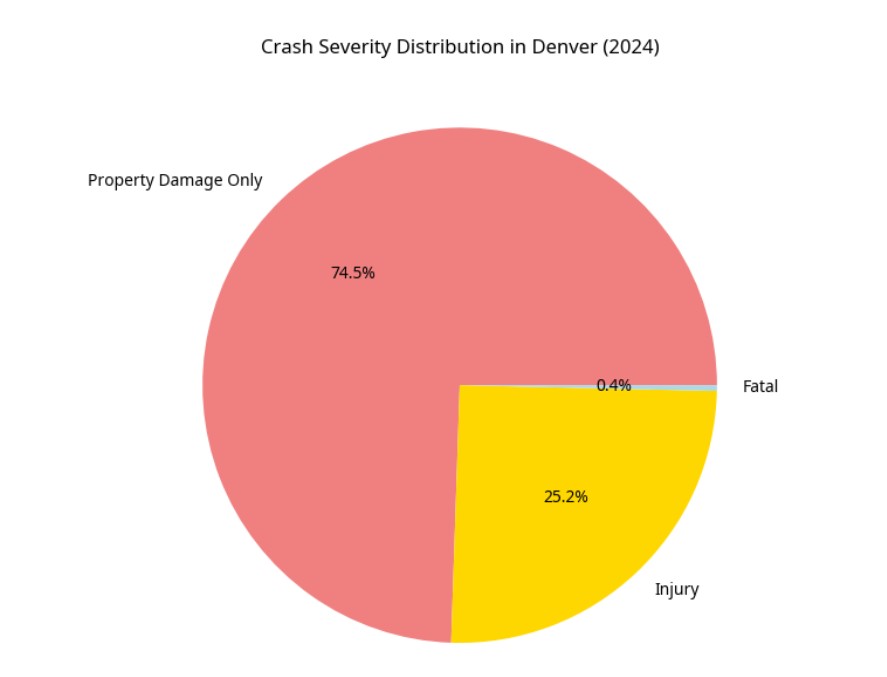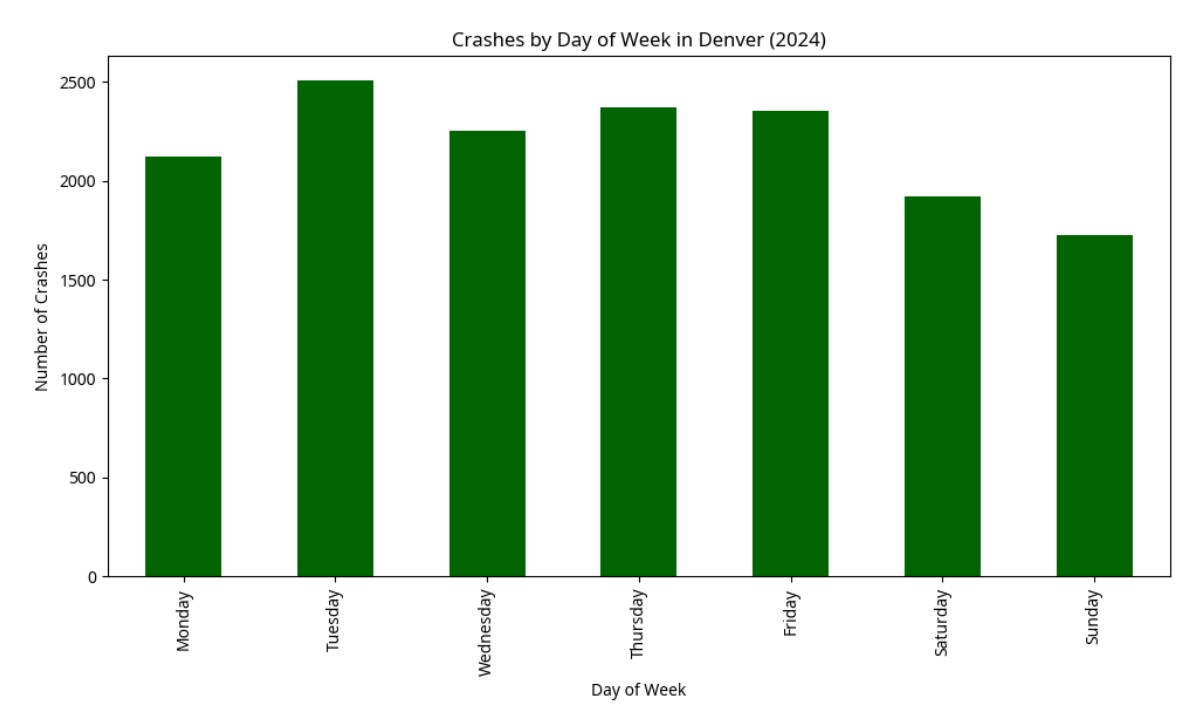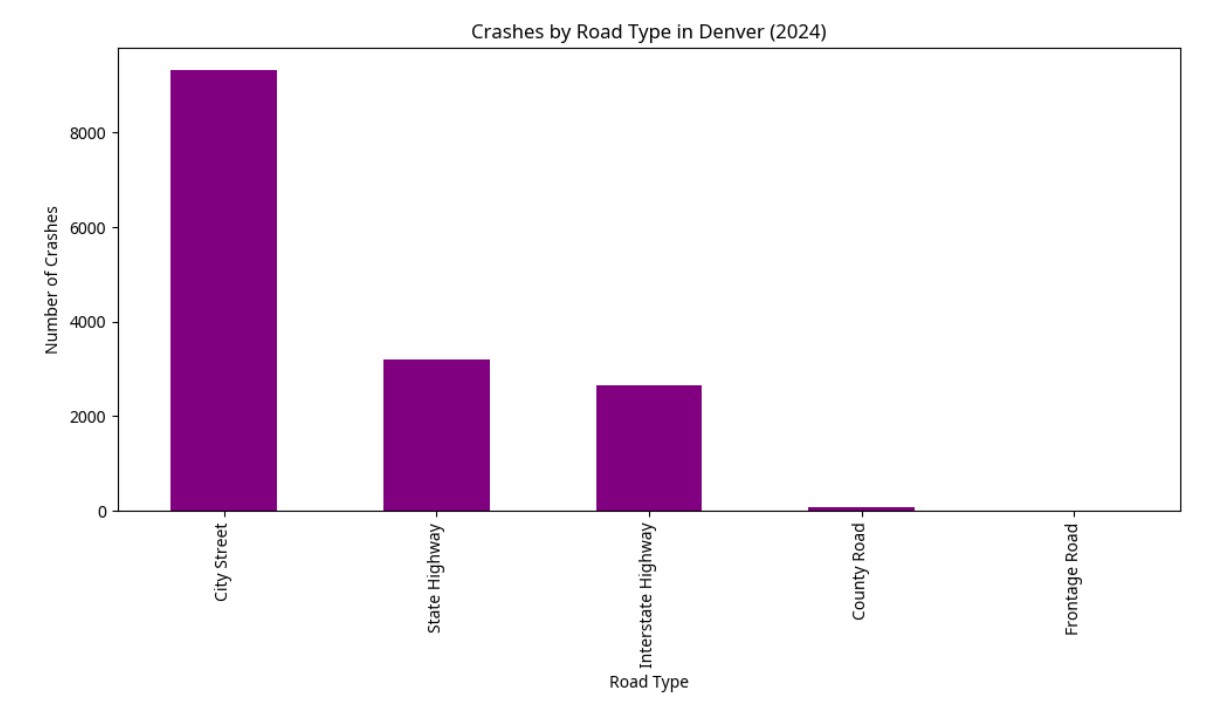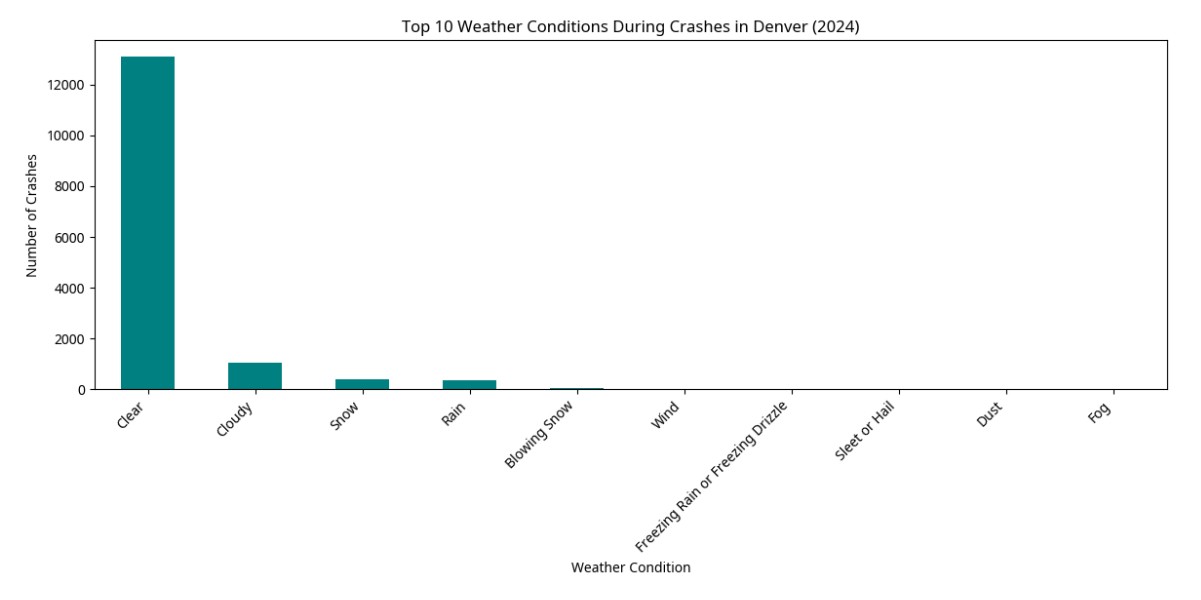In the heart of Denver, a car accident happens approximately every 34 minutes. This sobering statistic comes from a comprehensive analysis of 15,256 crashes that occurred within Denver city limits in 2024. Whether you’re a daily commuter, occasional visitor, or longtime resident, understanding the patterns behind these crashes could be crucial for your safety on Denver roads.
At Fuller Personal Injury Law, we’ve analyzed the latest data from the Colorado Department of Transportation (CDOT) to bring you insights that could help you avoid becoming part of these statistics—and know your rights if you do find yourself involved in a collision.
The Reality of Denver’s Roadways: By the Numbers
The 15,256 accidents that occurred within Denver city limits in 2024 tell a story about our roadways. While most resulted only in property damage, a significant number had more serious consequences:
- 74.5% (11,361) caused property damage only
- 25.2% (3,841) resulted in injuries, affecting 5,112 people
- 0.4% (54) were fatal crashes, claiming 55 lives
Behind these percentages are real people whose lives were dramatically altered in seconds. For every fatal crash, numerous others resulted in injuries that may have long-term consequences for the victims’ quality of life, ability to work, and financial stability.

Timing Is Everything: When Denver Crashes Most Often Occur
Understanding when crashes are most likely to occur can help you take extra precautions during high-risk periods.
Monthly Crash Patterns
Contrary to what many might expect, the worst month for accidents in Denver wasn’t during winter weather but in late summer. August topped the list with 1,450 crashes, followed closely by October (1,430) and September (1,402).
This late summer/early fall peak could be attributed to several factors:
- More vehicles on the road during summer tourism season
- School resuming in August/September, adding to traffic volume
- Longer daylight hours potentially leading to more time spent driving
December saw the fewest accidents with 995, which might reflect holiday travel outside the city or people staying home during winter weather.

Day of the Week Matters
If you want to avoid the most dangerous day on Denver roads, you might be surprised to learn it’s Tuesday, with 2,506 crashes recorded. This is followed by Thursday (2,374) and Friday (2,354).
The safest day to drive? Sunday, with just 1,724 crashes—nearly 800 fewer than Tuesday. This weekday concentration of crashes aligns with commuting patterns and higher business-related traffic during the workweek.

Location, Location, Location: Where Denver Crashes Happen
Not all roadways in Denver carry the same risk. The data shows a clear pattern in where accidents are most likely to occur:
- City streets: 61.1% (9,321 crashes)
- State highways: 21.0% (3,205 crashes)
- Interstate highways: 17.4% (2,658 crashes)
- County roads: 0.5% (69 crashes)
- Frontage roads: 0.02% (3 crashes)
The overwhelming majority of crashes happen on city streets—not on highways or interstates as many might assume. This suggests that the stop-and-go nature of city driving, with its traffic signals, pedestrian crossings, and frequent turning movements, creates more opportunities for collisions than the higher speeds but more predictable flow of highway traffic.
For Denver drivers, this means maintaining heightened awareness on local streets, particularly in high-traffic areas and during peak commuting hours.

Fair Weather Dangers: Environmental Factors in Denver Crashes
One of the most counterintuitive findings in the data is that most accidents don’t happen during challenging weather conditions:
- Clear weather: 85.8% (13,088 crashes)
- Cloudy conditions: 6.9% (1,059 crashes)
- Snow: 2.6% (391 crashes)
- Rain: 2.3% (343 crashes)
Similarly, road conditions at the time of crashes were predominantly favorable:
- Dry roads: 90.8% (13,849 crashes)
- Wet roads: 4.0% (613 crashes)
- Icy roads: 1.7% (259 crashes)
- Snowy roads: 1.0% (159 crashes)
This pattern could be explained by several factors:
- Denver experiences clear weather for most of the year
- Drivers may be more cautious during adverse weather conditions
- Traffic volume is likely higher during good weather
- Drivers may be more complacent when conditions seem ideal
The data on lighting conditions follows a similar pattern, with 67.9% (10,363) of crashes occurring during daylight hours. However, a significant 28.7% happened in dark conditions (both lighted and unlighted areas combined), highlighting the importance of visibility and the increased risk of nighttime driving.

The Human Element: Who and What Is Involved
Understanding the types of vehicles most commonly involved in crashes and the human factors that contribute to them can help drivers make safer choices.
Vehicle Types
The distribution of vehicle types involved in Denver crashes largely reflects what’s common on our roads:
- Passenger cars/vans: 52.5% (14,859 occurrences)
- SUVs: 24.7% (6,978 occurrences)
- Pickup trucks/utility vans: 13.0% (3,672 occurrences)
- Commercial vehicles: 2.4% (666 occurrences combined)
- Motorcycles: 0.9% (259 occurrences)
While motorcycles account for less than 1% of vehicles in crashes, their occupants face disproportionately higher risks of serious injury or death when collisions occur.
Human Contributing Factors
Perhaps the most important information for prevention comes from understanding the human behaviors that lead to crashes. After “No Apparent Contributing Factor” (which may reflect incomplete reporting), the most common contributing factors were:
- “Looked but did not see”: 7.3% (1,768 occurrences)
- Aggressive driving: 4.3% (1,037 occurrences)
- Distraction (interior and exterior): 5.9% combined (1,410 occurrences)
- Driver inexperience: 1.9% (457 occurrences)
- Driver unfamiliar with area: 1.4% (344 occurrences)
These statistics highlight the critical role of attention and attitude in safe driving. The “looked but did not see” factor suggests that many drivers are failing to fully process their surroundings despite believing they’re being attentive.
Staying Safe on Denver Roads: Practical Tips
Based on these statistics, here are specific recommendations for reducing your risk on Denver roads:
Timing Your Travel
- Consider adjusting your schedule to avoid Tuesday commutes when possible
- Be especially vigilant during August through October
- If flexibility allows, Sunday driving appears to be significantly safer
Route Selection
- Exercise extra caution on city streets, where most crashes occur
- Allow more time for city driving to reduce the temptation to rush
- Consider routes that minimize left turns across traffic, a common crash scenario
Weather Awareness
- Don’t let clear weather lull you into complacency—this is when most crashes occur
- Maintain defensive driving habits regardless of road conditions
- Remember that the transition between weather conditions (such as the first rain after a dry spell) can be particularly hazardous
Behavioral Adjustments
- Actively scan intersections and driveways, recognizing that “looking” isn’t the same as “seeing”
- Keep your attention on driving—interior distractions like phones and exterior distractions like billboards contributed to nearly 1,500 crashes
- Practice patience to avoid aggressive driving behaviors that contributed to over 1,000 crashes
Legal Considerations for Accident Victims
If you’re involved in a car accident in Denver, understanding the legal landscape can make a significant difference in your recovery process.
Colorado’s Comparative Negligence Laws
Colorado follows a modified comparative negligence rule. This means that if you’re partially at fault for an accident, your compensation may be reduced by your percentage of fault. However, if you’re found to be 50% or more at fault, you cannot recover damages from other parties.
Given that many crashes involve complex factors—such as the “looked but did not see” scenario—establishing the exact circumstances of your accident is crucial to your case.
Documentation Is Critical
The statistics show that seemingly minor details can be important factors in an accident case. If you’re involved in a crash, be sure to:
- Take photos of all vehicles involved, the surrounding area, and any visible injuries
- Obtain contact information from witnesses
- Note weather and road conditions
- Seek medical attention promptly, even if injuries seem minor
- Report the accident to your insurance company
- Consider consulting with a personal injury attorney before accepting any settlement offers
When to Seek Legal Help
While minor fender-benders might be handled directly with insurance companies, many situations warrant professional legal guidance:
- If there are any injuries, even seemingly minor ones
- If fault is disputed or unclear
- If multiple parties are involved
- If you’re dealing with aggressive insurance adjusters
- If the accident involved a commercial vehicle
- If the crash occurred in a high-risk scenario identified in the statistics (e.g., on city streets or during clear weather conditions where comparative negligence arguments are more common)
The Road Forward
Denver’s roads present unique challenges, as evidenced by the 15,256 crashes that occurred in 2024. Understanding the patterns—Tuesday’s higher risk, the predominance of crashes on city streets, and the counterintuitive danger of clear weather conditions—can help you adjust your driving habits to stay safer.
At Fuller Personal Injury Law, we’re committed to helping accident victims navigate the aftermath of a crash. Our deep understanding of Denver-specific accident trends allows us to build stronger cases for our clients.
If you or a loved one has been involved in a car accident in Denver, contact us for a free consultation. Our experienced team will help you understand your rights and options for recovery, ensuring that one moment on the road doesn’t define your future.
About Fuller Personal Injury Law
With almost 25 years of experience representing car accident victims in Denver, Fuller Personal Injury Law combines detailed knowledge of local traffic patterns with expertise in Colorado personal injury law. Our client-centered approach has recovered millions for accident victims while providing compassionate support throughout the recovery process. Contact us today at (720) 770-3832 for a free consultation.











